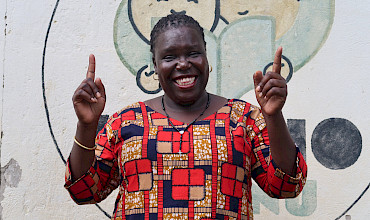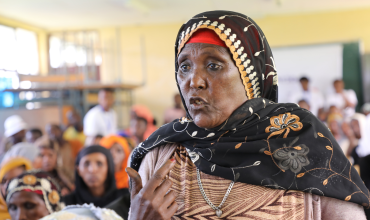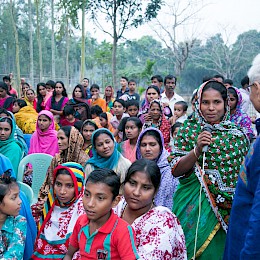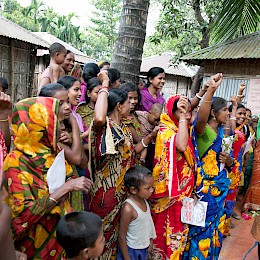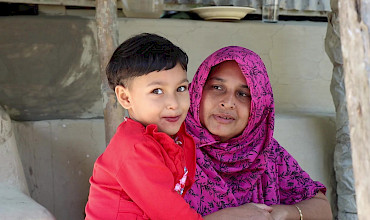
“Bangladesh has a wealth of excellent development projects but many of them remain isolated when they should be shared and upscaled.”, state Santanu Lahiri, Senior Consultant for HLP Foundation, and JB Rajan, KILA India.
Development efforts are usually implemented through projects. If the success of these projects is not adapted by local governments after the project ends, the learnings and practices are lost. This is where the Horizontal Learning Platform (HLP) Foundation comes in. “We capture good practices across sectors. If something works well in one region or country, we can replicate the same practices in other areas. This way, we avoid silos and save time and money.”, says Shafiqul Islam, President of HLP Foundation.
Why horizontal learning?
“I came to Bangladesh in 2007, as a consultant for the World Bank, to help develop an innovative project. This was when we started the Horizontal Learning Programme.”, Santanu explains, “We conceptualized HLP in Bangladesh. It was so successful due to the inspiring people and motivating colleagues working on it across boundaries. HLP is our passion.”
HLP is guided by appreciation-connection-learning principles: The first one is appreciation of knowledge. “We recognize that everyone is both a teacher and a learner.”, Hossein Shahbaz, Senior Consultant for HLP Foundation, explains. The second principle is connection, referring to the removal of barriers and building bridges between people. When people are connected, good practices can be adapted and then replicated in other contexts. “If a good practice can be replicated 50 times in different places, that means it is a best practice for us.”
How does HLP work?
Horizontal learning is an outcome-oriented process that supports the innate human ability to acquire tacit skills through copying the very best of what others do. There are plenty of projects triggering good practices in the social sector. However, these good practices and learnings often fade out with the projects. This is where HLP comes in: HLP aims to institutionalize positive practices. “We often try to identify the gaps and problems when we go to the field. Then we narrow it down to just a handful of problems because the project only has so much money. Indirectly, this creates frustration within the community. So instead, we go to the community to see which practices are working for them.”, says Santanu.
The basic assumption of HLP is that there is capacity within local institutions, within communities, individuals and countries. These capacities and practices just need to be connected and replicated. Defined as “outcome-based peer-learning”, HLP supports governments in identifying good practices and acts as a catalyst to foster connections with peers. Capacity building often starts with international funds. When local governments decide what they want to learn themselves, they will replicate it with their own money. This way, the ownership shifts to the local level and best practices are institutionalized and integrated into policies. The impact: Instead of policies implemented from the top down, HLP is creating an environment where local governments become ambassadors of new concepts, from the bottom up.
Max Foundation’s Nutri-WASH Healthy Village Bangladesh programme provides a great example of HLP in action. In Bangladesh, villages receive the title “healthy” when 90% of their population fulfills key criteria. Through HLP’s learning and sharing component, more villages throughout the country can be “healthy”.
Right2Grow and HLP: growing together
Right2Grow reaches 40 out of over 4500 Unions, the lowest rural administrative and local government unit, in Bangladesh at the current moment. HLP - functioning as the catalyst - connects these 40 unions amongst each other, as well as with the other local governments working in the WASH and nutrition arena. This way, practices that work well can then go up to the highest policy level and reach policy change. “HLP is the process of scaling up successful pilots within the country by working on the peer level.”, says Shahbaz. “We can bridge small pilots with the bigger picture. We are expecting to make a big difference.”, adds Santanu.
Hear from HLP Foundation at our official N4G side event
“In the private context, many of us experience a higher level of appreciation - more heart. In the work context, at the office, it is usually more professional - we work from the mind. To create real change, you have to use your heart and your mind. If there is proper appreciation, communication, and connection, our messages will come across. So, communication plays a vital role at HLP.”, Santanu explains.
We invite you to join us on December 9th, directly following the Nutrition For Growth Summit, for our official N4G side event “Mutual accountability for nutrition and health: what can be learnt from best practices in multi stakeholder collaboration?” and learn more about the HLP way. Read about the event here.
Back to overview
